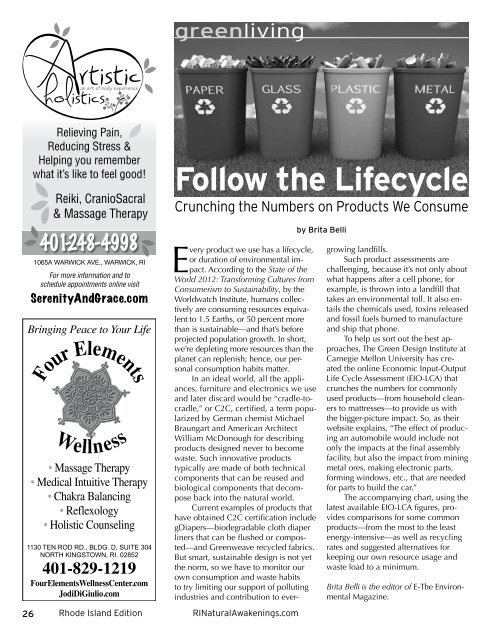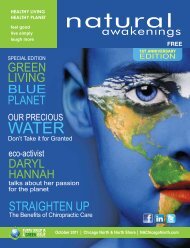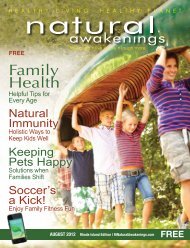Providence, RI - Natural Awakenings
Providence, RI - Natural Awakenings
Providence, RI - Natural Awakenings
You also want an ePaper? Increase the reach of your titles
YUMPU automatically turns print PDFs into web optimized ePapers that Google loves.
Relieving Pain,<br />
Reducing Stress &<br />
Helping you remember<br />
what it’s like to feel good!<br />
Reiki, CranioSacral<br />
& Massage Therapy<br />
401-248-4998<br />
1065A WARWICK AVE., WARWICK, <strong>RI</strong><br />
For more information and to<br />
schedule appointments online visit<br />
SerenityAndGrace.com<br />
Bringing Peace to Your Life<br />
Four Elements<br />
Wellness<br />
• Massage Therapy<br />
• Medical Intuitive Therapy<br />
• Chakra Balancing<br />
• Reflexology<br />
• Holistic Counseling<br />
1130 TEN ROD RD., BLDG. D, SUITE 304<br />
NORTH KINGSTOWN, <strong>RI</strong>. 02852<br />
401-829-1219<br />
FourElementsWellnessCenter.com<br />
JodiDiGiulio.com<br />
greenliving<br />
Every product we use has a lifecycle,<br />
or duration of environmental impact.<br />
According to the State of the<br />
World 2012: Transforming Cultures from<br />
Consumerism to Sustainability, by the<br />
Worldwatch Institute, humans collectively<br />
are consuming resources equivalent<br />
to 1.5 Earths, or 50 percent more<br />
than is sustainable—and that’s before<br />
projected population growth. In short,<br />
we’re depleting more resources than the<br />
planet can replenish; hence, our personal<br />
consumption habits matter.<br />
In an ideal world, all the appliances,<br />
furniture and electronics we use<br />
and later discard would be “cradle-tocradle,”<br />
or C2C, certified, a term popularized<br />
by German chemist Michael<br />
Braungart and American Architect<br />
William McDonough for describing<br />
products designed never to become<br />
waste. Such innovative products<br />
typically are made of both technical<br />
components that can be reused and<br />
biological components that decompose<br />
back into the natural world.<br />
Current examples of products that<br />
have obtained C2C certification include<br />
gDiapers—biodegradable cloth diaper<br />
liners that can be flushed or composted—and<br />
Greenweave recycled fabrics.<br />
But smart, sustainable design is not yet<br />
the norm, so we have to monitor our<br />
own consumption and waste habits<br />
to try limiting our support of polluting<br />
industries and contribution to ever-<br />
26 Rhode Island Edition <strong>RI</strong><strong>Natural</strong><strong>Awakenings</strong>.com<br />
Follow the Lifecycle<br />
Crunching the Numbers on Products We Consume<br />
by Brita Belli<br />
growing landfills.<br />
Such product assessments are<br />
challenging, because it’s not only about<br />
what happens after a cell phone, for<br />
example, is thrown into a landfill that<br />
takes an environmental toll. It also entails<br />
the chemicals used, toxins released<br />
and fossil fuels burned to manufacture<br />
and ship that phone.<br />
To help us sort out the best approaches,<br />
The Green Design Institute at<br />
Carnegie Mellon University has created<br />
the online Economic Input-Output<br />
Life Cycle Assessment (EIO-LCA) that<br />
crunches the numbers for commonly<br />
used products—from household cleaners<br />
to mattresses—to provide us with<br />
the bigger-picture impact. So, as their<br />
website explains, “The effect of producing<br />
an automobile would include not<br />
only the impacts at the final assembly<br />
facility, but also the impact from mining<br />
metal ores, making electronic parts,<br />
forming windows, etc., that are needed<br />
for parts to build the car.”<br />
The accompanying chart, using the<br />
latest available EIO-LCA figures, provides<br />
comparisons for some common<br />
products—from the most to the least<br />
energy-intensive—as well as recycling<br />
rates and suggested alternatives for<br />
keeping our own resource usage and<br />
waste load to a minimum.<br />
Brita Belli is the editor of E-The Environmental<br />
Magazine.





